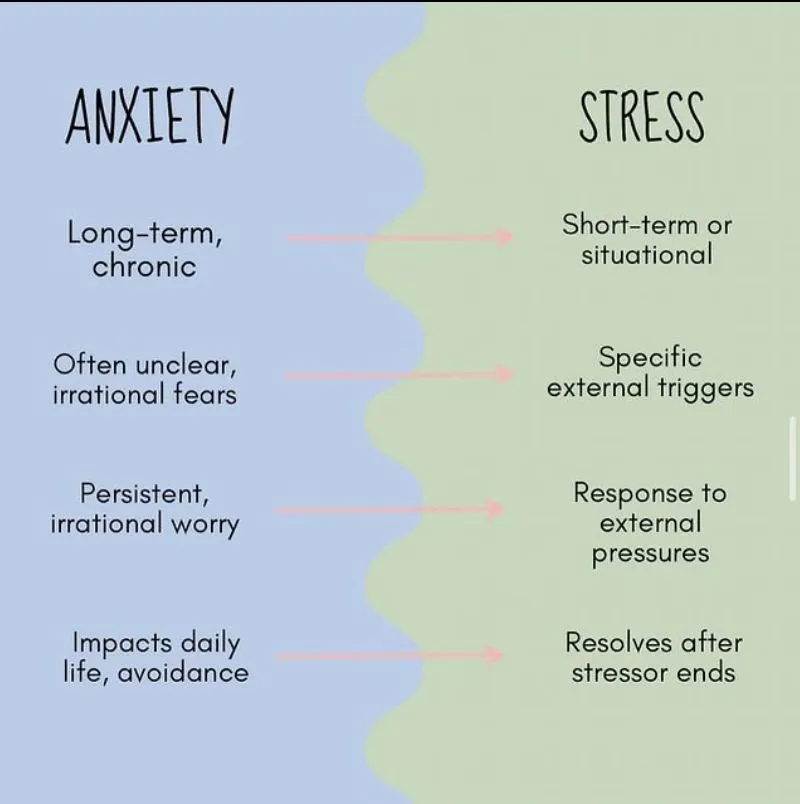Nearly 19% of U.S. adults experience an anxiety disorder each year, yet many don't realize the difference between normal anxious feelings and clinical anxiety. While feeling anxious before big events is normal and temporary, anxiety disorders involve persistent worry that interferes with daily life for weeks or months. Learn the key differences and when to seek professional support.
The Question That Keeps You Up at Night
We all feel anxious sometimes—before a job interview, after receiving a vague message, or right before presenting to a room full of people. These moments can be uncomfortable, but they're also completely normal. Anxiousness is part of how your brain prepares you for situations that feel uncertain or high-stakes. It's temporary and usually tied to something specific. But what if your worry doesn't have a clear cause? What if it stays long after the triggering moment has passed, showing up in the middle of calm days or before you even get out of bed? According to the National Institute of Mental Health, 19.1% of U.S. adults experience an anxiety disorder each year, yet many don't realize when normal anxious feelings have crossed into something that requires attention and support.
Normal Anxiousness: Your Brain's Protective System
Situational and Time-Limited
Normal anxious feelings are typically connected to specific situations or events. You feel nervous before a presentation, worried about a medical test result, or anxious about a first date. This type of anxiety usually lasts hours to a few days and resolves once the situation passes or you've had time to process it. It's your brain's way of helping you prepare, stay alert, and perform well under pressure.
Motivating Rather Than Paralyzing
Healthy anxiety often motivates positive action. It might prompt you to prepare thoroughly for an exam, practice a speech, or think through potential challenges. While uncomfortable, it doesn't prevent you from functioning or making decisions. You can still sleep, concentrate on other tasks, and maintain your normal routines even while feeling anxious about a specific upcoming event.
Proportionate to the Situation
Normal anxiety matches the reality of the situation. Feeling nervous about a job interview makes sense—it's an important event with real consequences. The intensity of your worry generally aligns with the actual significance or risk involved in the situation you're facing.
When Anxiety Becomes a Disorder: Recognizing the Signs
Persistent and Pervasive Worry
Anxiety disorders involve worry that persists long after triggering events have passed—often lasting weeks or months. The American Psychiatric Association defines this as excessive fear or anxiety that interferes with daily activities. You might find yourself constantly worried about multiple aspects of life, from work performance to family health to minor daily tasks, even when there's no clear reason for concern.
Physical Symptoms That Won't Quit
While normal anxiety might cause temporary physical symptoms, anxiety disorders create ongoing physical distress. This can include persistent muscle tension, fatigue, difficulty sleeping, headaches, digestive issues, or feeling constantly 'on edge.' Your body stays in a state of high alert even when you're in safe, familiar environments.
Interference with Daily Functioning
The key difference is impact on your life. Anxiety disorders significantly interfere with work, relationships, sleep, or daily activities. You might avoid certain situations, have difficulty concentrating, struggle to make decisions, or find that worry consumes much of your mental energy throughout the day. Simple tasks can feel overwhelming when anxiety is running the show.
The Numbers Tell a Story You're Not Alone In
Understanding anxiety disorders becomes clearer when you see how common they are. World Health Organization data shows that 4% of the global population—over 301 million people—currently experience an anxiety disorder, making them the most common mental health conditions worldwide. In the United States, women are twice as likely as men to experience anxiety disorders, and symptoms typically begin around age 13, though they can develop at any age. Perhaps most concerning is that only about 1 in 4 people with anxiety disorders receive treatment, often because they don't recognize that what they're experiencing goes beyond normal worry and stress.
Common Types of Anxiety Disorders and How They Feel
Generalized Anxiety Disorder (GAD)
GAD involves persistent, excessive worry about multiple life areas—work, health, family, finances—even when there's little reason for concern. People with GAD often describe feeling like they're waiting for the other shoe to drop, constantly anticipating problems or disasters. The worry feels uncontrollable and exhausting, affecting concentration and sleep.
Social Anxiety Disorder
This involves intense fear of social situations where you might be judged, embarrassed, or rejected. Unlike normal social nervousness, social anxiety disorder can prevent you from participating in work meetings, social gatherings, or even routine interactions like ordering food. The fear is often disproportionate to the actual social threat.
Panic Disorder
Characterized by recurrent panic attacks—sudden episodes of intense fear with physical symptoms like racing heart, sweating, trembling, or feeling like you can't breathe. The fear of future panic attacks can become so consuming that it leads to avoiding places or activities where attacks have occurred.
What You Can Do: Managing Both Anxious Moments and Ongoing Anxiety
For Normal Anxious Feelings
When experiencing situational anxiety, try grounding techniques like deep breathing exercises, progressive muscle relaxation, or brief walks. Limit caffeine, which can amplify anxious feelings. Practice mental reframing by asking yourself: 'What do I need right now to feel grounded?' Often, normal anxiety responds well to preparation, self-care, and time.
For Persistent Anxiety
If worry continues for weeks or months and interferes with your life, professional support can make a significant difference.
Understanding the difference between stress and anxiety can help you identify what type of support you need. Cognitive-behavioral therapy (CBT) has strong research support for anxiety disorders, and medication can also be helpful when recommended by healthcare providers.
Building Long-Term Resilience
Whether dealing with normal anxiety or anxiety disorders, certain practices support overall mental health: regular exercise, adequate sleep, mindfulness practices, journaling, and maintaining social connections.
When overthinking won't stop, these foundational practices become even more important for managing persistent worry patterns.
When to Seek Professional Support
Consider consulting a mental health professional if you notice that worry sticks around for weeks without clear cause, if it's hard to relax even in quiet moments, if your body always feels tense or alert, or if anxiety is interfering with work, relationships, or daily activities. Other signs include avoiding situations due to anxiety, experiencing panic attacks, or using alcohol or substances to cope with worry. Remember that seeking help isn't about weakness or failure—it's about recognizing when your brain's protective system needs some recalibration. Many highly effective treatments exist for anxiety disorders, from therapy approaches that teach new ways of thinking and coping, to medications that can provide relief while you develop other skills.
You're Human, Not Broken
Whether you're dealing with normal anxious feelings or clinical anxiety, your experience is valid and you deserve support. Anxiety—in any form—doesn't mean you're weak, overly sensitive, or not managing life well enough. It often reflects a nervous system that's been working overtime to protect you, sometimes without adequate rest or support. Your mental clarity matters, and so does your peace. The goal isn't to never feel anxious again—that would be neither possible nor healthy. The goal is to develop the awareness and skills to distinguish between helpful anxiety that motivates positive action and unhelpful anxiety that interferes with your wellbeing. With the right support and strategies, both normal anxiety and anxiety disorders are very manageable, allowing you to lead a full, meaningful life.





